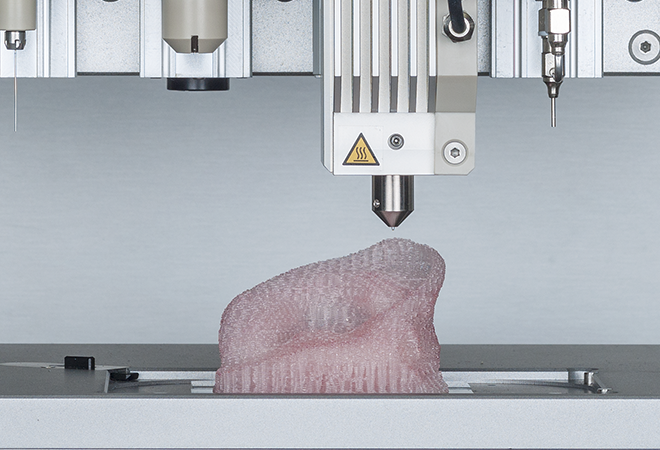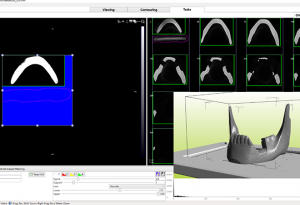Nestled in the Fribourg countryside, amid medieval towns, deep mountain lakes, and Swiss-alpine traditions, bioprinting company regenHU (which stands for regeneration human) is developing some of the most advanced 3D printers in Europe and creating alliances with research institutions that are quickly making it a leader in this emerging field. Recent advances have given them the tools for fabrication of biomimetic tissue constructs, tissue growth technologies, and drug discovery. Just over a month ago, researchers at Tel Aviv University used regenHU’s 3DDiscovery printer to create cardiac patches and cellularized hearts for patients with heart failure, using patient-specific hydrogel as bioink, so as to avoid rejection. Working in multiple projects alongside their partners, such as the University of Glasgow, in Scotland; the United States National Institutes of Health, and the AO Research Institute in Davos, among others, regenHU is one of the go-to-bioprinting companies of the region. Looking forward to the next ten to twenty years, CEO and founder Marc Thurner is convinced that the future is in regenerative medicine and that their printers could make 3D printed implantable living organs a reality.
A pioneer in the bioprinting realm, regenHU’s story began in 2007 when bioprinting companies were just beginning to fill a much-needed void in the medical and research community. At that time there were three bioprinting companies, including San Diego-based Organovo. regenHU chose to exploit the potential of bioprinting in the therapeutical area and founded a unique corporate structure along with academic partners and affiliate companies which develop innovative transformational products into the medical environment.
Thurner explained to 3DPrint.com that his “vision was to use additive manufacturing to create a three-dimensional biological environment in which to combine cells, bioactive and extracellular, like biomaterials in order to enable the cell to cell interactions and create physiological pathways that mimic the ones found in natural tissues and organs.”
At the time, as Thurner came around to that concept, the scientific community was still very skeptic about printing cells and proteins. “
“So regenHU had to face the difficult and resource consuming challenge to demonstrate cell printability and post-printing survival,” he said.
There were many other doubts, including whether the cells would be able to survive or even keep their morphologies. This was successfully achieved in 2009 and gave rise to a new industry of tissue printing. Still, the bioprinting industry is far from learning how all the applications of the machines work.
regenHU has done a lot to level the ground for bioprinting in Europe and overcome skepticism. Partnering with Ursula Graf-Hausner, a biologist and chemist specializing in tissue engineering cell culture technique at the Zurich University of Applied Sciences who was working with primary human cells and creating human tissue, looking to create the Tissue Engineering for Drug Development center at the university.
But dealing with live cells was no easy task, at first 3D printed cells did not survive, and although there were many cell-compatible biomaterials on the market, none of them solidified fast enough after printing. So the duo added biologist Markus Rimann, who had the idea of developing a chemically defined bioink, which made printing the material possible.
Since its start, the company has grown significantly, acting as a capital equipment provider and delivering cutting-edge bioprinting instruments to world-leading scientific and clinical institutions. Some of their clients include L’Oreal, Novartis Pharmaceuticals, among others. regenHU uses cells, proteins and extracellular matrix to make their biogels used in the creation of different tissue types, developing a unique knowledge about what ingredients and conditions are required to drive a specific tissue formation. This knowledge is the result of multiple research endeavors done along with academic and industrial research institutions.
“The evolution of biology is quite a slow process, scientists are still learning and understanding the basics behind the science. So our mission is to support their discovery providing dedicated scientific instruments. We hope that within the next ten years they will find the recipe to biomanufacturing simple tissue and believe that the future of bioprinting is in drug discovery, personalized medicine, precision medicine, and of course, organ transplant,” explained Thurner.
With more than 40 well-established bioprinting companies in Europe today, regenHU is still gaining ground. Furthermore, in an attempt to conquer the growing demand for dental 3D printing applications, regenHU together with the dental faculty at the University of Geneva created a spin-off company, Vivos Dental, to develop, manufacture and market oral bone augmentation solutions, like their patented OsteoFlux®, a 3D printed synthetic bone graft for oral bone augmentation and bone regeneration that is still in development. This could be a great option for patients who do not have enough bone volume for a dental implant, so Vivos Dental’s objective is to augment bone volume to offer a good attachment area. It’s an exciting time for dental 3D printing, especially as it is forecast to become an over four billion dollar market for dental prosthetics, orthodontic appliances, and other dental parts.
Bioprinting is no longer an early-stage technology, it has transitioned to the clinical environment, which is why regenHU developed 3DDiscovery Evolution, which is not just a bioprinter, it is a technology platform that can evolve with the researchers’ needs and offer optimal tools that can be integrated into a manufacturing process. RehenHu’s machines are being used to print skin patches for grafting onto burn victims, to develop muscle tissue models by pharmaceutical company Novartis, and even to print cartilage for joint repair.
A couple of years ago, regenHU realized that software technology is also a very important tool to enable bioprinting applications that would allow scientists to exploit their potential, so they invested in software tools, like BioCAD which allows researchers without an engineering background to draw in a layer-by-layer way the tissue they want to create, while BioCAM can import 3D data from medical scanners and modify structures for 3D printing.
As part of their expansion to new markets, clients and researchers, last year regenHU appointed San Diego-based lab automation solutions provider Wako Automation as its official systems integrator for the US.
For regenHU, it’s all about contributing to the bioprinting industry by coordinating projects with academia, pharma users, biotech institutes and cosmetic companies that invest in these type of products. It’s part of their 3D discovery evolution and a way to learn how to control cellular biology to eventually develop some of the most sought after advances in regenerative and therapeutic medicine, like advances in biomimetic tissue constructs, to mimic an environment as close as possible to the in vitro situation.
Although having multiple collaborations around the globe and developing an ecosystem of partners and users are making waves within the biofabrication community, some areas, like developing vascularization to help create functional large organs is still challenging, so regenHU, like other bioprinting pioneers and leading companies, is looking for answers. It might take years before a big leap takes researchers to the next level in bioprinting.
[Images: regenHU]Subscribe to Our Email Newsletter
Stay up-to-date on all the latest news from the 3D printing industry and receive information and offers from third party vendors.
Print Services
Upload your 3D Models and get them printed quickly and efficiently.
You May Also Like
The Market and Industry Potential of Multi-Material 3D and 4D Printing in Additive Electronics
Additive manufacturing leverages computer-based software to create components for products by depositing either dielectric or conductive materials, layer by layer, into different geometric shapes. Since its birth in the 1980s,...
3DPOD 262: Bio-inspired Design for AM with Dhruv Bhate, Arizona State University
Dhruv Bhate is an associate professor at Arizona State University. There, he looks at structures, materials, and design. Previously, he worked at PADT as well as in the semiconductor and...
3DPOD 261: Tooling and Cooling for AM with Jason Murphy, NXC MFG
Jason Murphy´s NXC MFG (Next Chapter Manufacturing) is not a generalist service; instead, the company specializes in making tooling. Using LPBF and binder jet, the company produces some of the...
3DPOD 260: John Hart on VulcanForms, MIT, Desktop Metal and More
John Hart is a Professor at MIT; he´s also the director of the Laboratory for Manufacturing and Productivity as well as the director of the Center for Advanced Production Technologies....




































